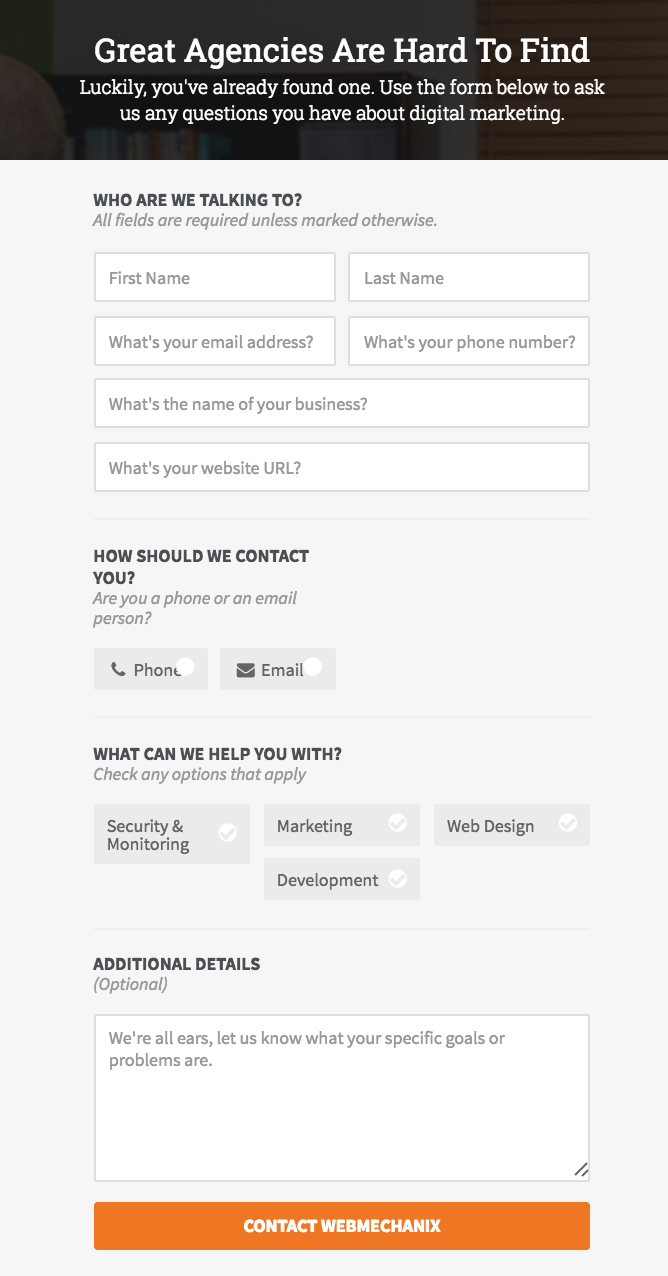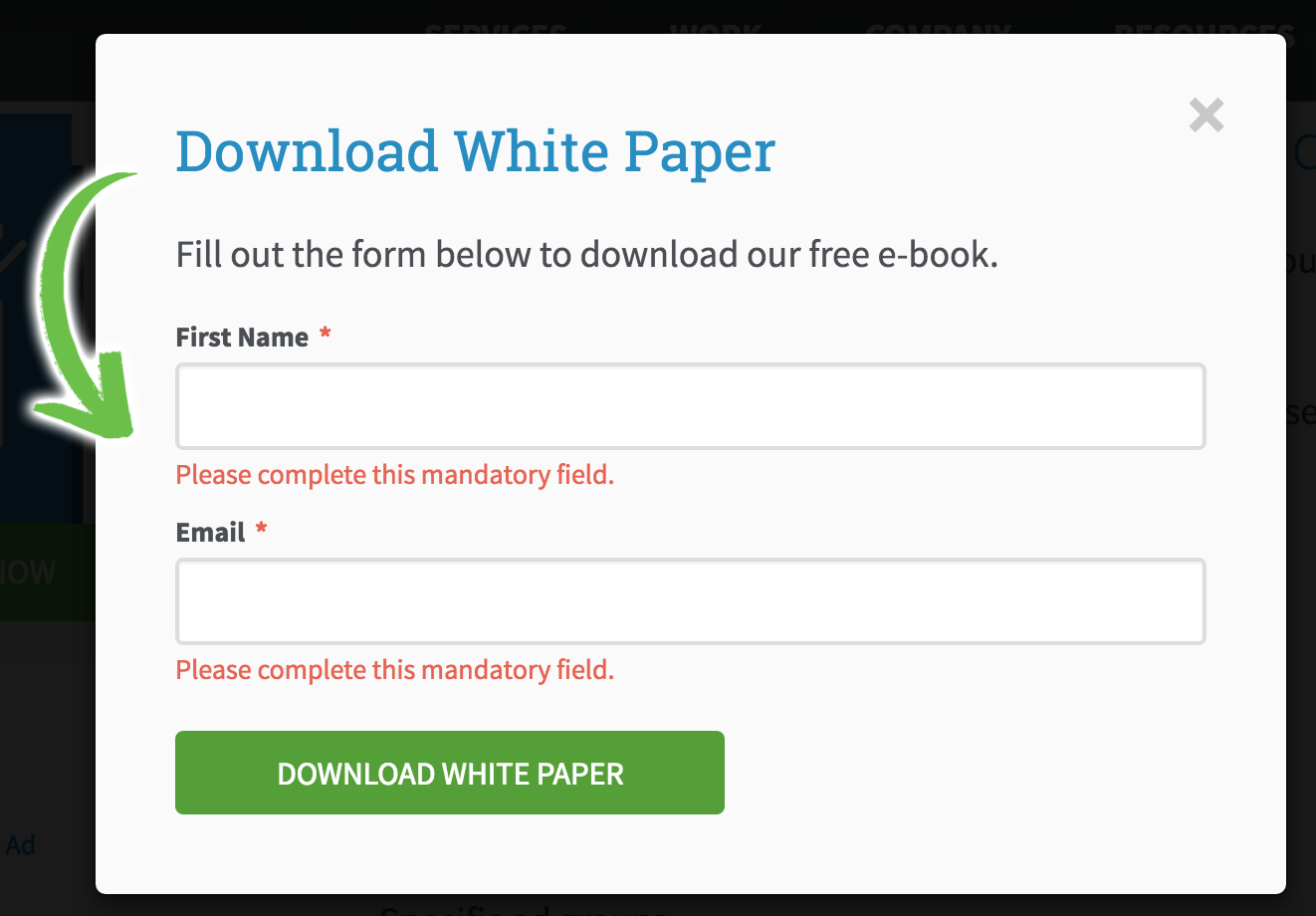
Here’s Why Your Web Leads Are Unresponsive (& The Stupid Easy Way to Fix It)
You know the story — your digital marketing efforts are driving more and more leads each month. Google Analytics charts keep going up and to the right. (*Warning shameless plug* If this doesn’t sound familiar, we should talk — https://www.webmechanix.com/contact/.) Your marketing department is ecstatic.
So you’re ready to ask the hard question — “What’s the impact of all of these leads we’re generating?” You’re ready to close the marketing-to-sales loop.
So, you talk with your sales team. But they aren’t sharing your enthusiasm…. “Thanks for all the leads,” they say, “but we can’t get back in touch with — like — 80% of them. They don’t reply to email. They don’t pick up the phone. They’ve just gone dark.”
WHAT!? You’re scratching your head. You dig back through your form submissions. The leads look legit. Real phone numbers. Real email addresses with domains of companies that fit your ideal customer profile. It doesn’t make any sense. What the heck is going on?
Sound familiar? Trust me, you’re not alone. In this blog post you will find 3 common mistakes that lead to unresponsive web leads and tips to increase your web lead response rate.
Setting expectations… stop the funny business [IF NOTHING ELSE READ THIS]
If you take nothing away from this blog post, remember this: Your website visitors are real people, who are on your website for a reason.
Not only that but, users filling out lead forms on your website are interested in whatever the form is promising. Otherwise, they wouldn’t have taken the time to fill the darn thing out.
Now here’s the key: What did you promise? In other words, what is supposed to happen after the visitors submits a form? What expectations did you set… from the user’s perspective?
Here are 3 common mistakes to learn from:
Mistake #1: No expectations are set. Like at all.
These are the forms that are all take and no give. They want all of your information, and tell you squat about what’s going to happen next.

It’s a shock that these kinds of forms get completed at all. But it’s not really a shock when the user doesn’t respond to follow up contact attempts. They’ll be thinking things like this:
- Am I completing the right form?
- Are they going to call me? Or email me? When? I really hope they email me, because I screen all my calls.
- Who is going to be in touch with me? Can they actually help?
- How are they supposed to know what I need from this form? I gave them no information.
- So I filled out your form, where do we go from here? Seems like I’m in for some time wasting…
So when they receive a vague voicemail or email about a follow up, it’s no surprise they don’t answer. The sales person doesn’t even know what they want, so how can they possibly entice them into responding?
Solution: Answer the WHY, HOW & WHAT
Rather than having a generic “Contact Form” that tells the user nothing, make it crystal clear why the form should be completed and what action will result. The form below uses several obvious tactics that just plain work:
- It tells you WHY to use the form
- It asks you HOW you prefer to be followed up with
- It asks you WHAT you need help with in a checkbox (so you can complete the form more quickly). It also asks for additional details with an open text field (in case the the checkbox didn’t cover your entire request).

If someone fills out a form like this, there’s no reason they shouldn’t respond to your follow ups, because they know exactly:
- WHY they are filling it out;
- WHAT they are asking; and
- HOW they will be contacted.
And not only that, but the person contacting them actually knows what they user wants because they were able to describe it in a form with an actual purpose.
Can this example be made better? Sure. How about alleviating concerns like:
- WHEN are you going to contact me?
- How LONG is the conversation going to take?
- Do I need to have anything PREPARED for when you call / email?
Answering as many of these questions before a user completes a form is ideal. But sometimes, too much content, or too many form fields, videos, pictures, etc. detract from conversion rates. So, in these scenarios, you have a very effective, but often overlooked, tool at your disposal, which will be the topic of a later post: Thank You Pages / Messages / Emails.
Mistake #2: The bait and switch
Ever have your phone creepily start ringing 14 seconds after submitting a web form? As you hit the ignore button, you think, “If I wanted to talk on the phone, I would’ve just called. There’s a reason I submitted a form instead. I’m a busy person. Don’t they get that?”
I call this the bait and switch and it’s an obnoxious (and also ineffective) way to generate sales. You’ll know these forms because they provide no indication, whatsoever that a phone call is necessary to proceed. The business thinks like this:
“Well I can’t do anything with the lead until I speak with them on the phone… But I’m not going to tell them that because then they’ll never fill out the form… So I’ll make it seem like they are filling out a form to get in touch with us online, but really as soon as that phone number hits the CRM my sales team is going to call them… But for some reason, nobody is answering our calls! Must be junk leads…”
The problem is that while tricking the user led to the collection of contact details, the user didn’t want to talk on the phone to begin with. That’s why they completed a form (or so they thought).
If they knew that they HAD to speak on the phone to continue with the process, then that’s a different story. But the website never said that, did it?
Solution: Set expectations BEFORE the form is filled out
If you properly set expectations before a user completes a form, there’s very little reason for the user to dodge your follow up calls and emails. In fact, they should expect them.
Let that marinate for a second.
Now, let’s revisit the bait and switch. Imagine what language above the form can do to help set expectations. What if we said something like this:
In order to best serve you we will need to speak with all potential customers over the phone. For your convenience please use the form below to schedule a call. Most calls last less than 5 minutes.
Do you think someone would fill out the form and not answer the call now? Well since they are still using a form, they probably aren’t ready to talk just yet. How can you remedy that? With a simple, yet powerful form field: “When is the best time to call you?”

Now, do you think someone would complete the form and not answer the call? Probably not 🙂 Problem solved.
Again, your thank you messaging can be leveraged here as well, but that’s another topic, for another post.
Mistake #3: Not letting marketing automation do its job
You’re excited about your new marketing automation tools and strategy. You know ebooks and white papers are as good as gold to your market. You’ve carefully crafted many of them, and users are gladly giving up their email address in exchange for the downloads. You’re convinced sales can’t help but increase with your new top of the funnel strategy. The pipeline is increasing!
But it’s the same story again — the sales team can’t get in touch with anyone. They’re calling the leads junk. Upper funnel marketing is coming under scrutiny by the executive team.
Well, duh! Your form said, fill out this form for a free White Paper Download — not, fill out this form to be pestered by our sales team. Did the user even get a chance to read the thing before sales started calling and emailing?

If you don’t let the “automation” part of marketing automation work the user down the funnel into becoming sales ready, you are wasting a lot of people’s time: your own, your sales teams, your writers, and most importantly, your precious customers.
Solution: Respect the funnel
White paper downloads are the definition of upper funnel. And if you’re going after upper funnel leads, you need to remember that they are at the top of the funnel for a reason. If the lead wanted to speak with a salesperson they’d just call or fill out your request a quote form.
But they didn’t, so you need to slow down, play it cool, and wait for the lead to declare itself sales worthy.
How do you do that? By letting marketing automation do it’s job and nurture the lead for you. Start by thinking about what content would logically move someone through a decision making phase.
Here’s a simple approach:
- If someone downloads a white paper then they would probably be interested in a case study that’s related to the first white paper download. Drip that to them.
- Now that they know you are an authority (evidenced by white paper) and they know you are a performer (evidenced by case studies) they are probably ready for a light pitch. So, drip an email filled with testimonials and reviews.
- Next hit them with a benefits driven sales email, aimed at getting them to commit to a quick conversation.
If someone has gone through this series, not unsubscribed, and opened every one of these emails, then go ahead and unleash the sales hounds 🙂
Getting your web leads to respond
It pains me when companies think they need a new website, a new marketing firm, a new expensive this or that to be able to get more “qualified” leads, when lead quality is often never an issue to begin with. If someone was really that unqualified, would they take the time to visit your site and fill out your forms?
It’s all about expectation setting. It’s not sexy. And it’s not fun (except for the geeks like me.) And it’s so painfully obvious that it’s a thankless job. But it matters, and HUGE companies mess it up all the time!
In fact, when it comes to anything with your website a lot of problems can be solved (read: a lot of money can be made) by:
- Not trying to be clever
- Not trying to innovative
- Not trying to creative
In fact, if you just tell people WHO you are, WHAT you do, HOW you’ll help them, and WHY they should work with you, and you make a good case for it, well then anyone finding your website would be a fool not to convert — and certainly a fool not to respond to your follow ups.
Test out this approach, and I think you’ll be shocked by the results.
Looking for digital marketing help for your business? I think you’ll find our contact form sets expectations very well: https://www.webmechanix.com/contact/. Go ahead and give it a try 😉
[Case Study] Learn How A Financial Services Company Doubled Leads By Properly Setting Expectations In Just 2 Months >>
Most newsletters suck...
So while we technically have to call this a daily newsletter so people know what it is, it's anything but.
You won't find any 'industry standards' or 'guru best practices' here - only the real stuff that actually moves the needle.







